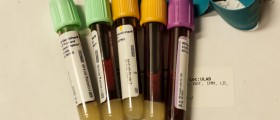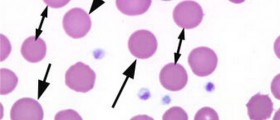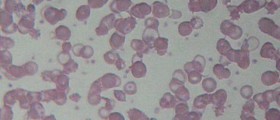
Sickle cell anemia is hereditary, chronic and life lasting blood disease affecting the red blood cells and hemoglobin which enables the transfer of oxygen from the lungs to all parts of the body. Under the influence of hemoglobin C and S normal red blood cells change shape into the sickle form. This process damages the red cell membrane whereby the cells becomes more rigid, easily breaks having difficulties in passing through blood vessels clogging them.
Symptoms of this disease vary from person to person. The most common symptoms include:anemia assuming reduced number of red blood cells, which is accompanied by fatigue, paleness, shortness of breath and skin and eye jaundice slower children growth and later puberty than in healthy children, adults are often thin and short the formation of stones in gallbladder when the level of bilirubin in the body is high; bilirubin is produced during decomposition of red blood cells; stone in the gallbladder often causes pain for 30 minutes or more in the top right corner of the abdomen, below the right shoulder or between the shoulder blades.obstruction of capillaries and restriction of blood flow and providing oxygen to the body, which leads to vaso-occlusive crisis, also known as pain crises, followed by ischemia, pain and irreversible organ damageunusual and strong pain in any organ, bones or joints. Some patients have these painful crises less than once a year, while others have 15 or more crises a year. Pain can be acute lasting from several hours to several days, chronic long-lasting for 3-6 months or longer or a combination of these twobones, especially those which carry the body weight such as femur, tibia, humerus are the target of vaso-occlusive damage. Aseptic necrosis of bone often occurs as a consequence. a vaso-occlusive crisis affects the joints and soft tissue, which results in hand-foot syndrome. When sickle red blood cells block small blood vessels in hands or feet, there is pain and swelling accompanied by fever which may be the first sign of sickle anemia in children.disease can attack the abdominal organs which may lead to interruption of the spleen, where it becomes fibrous and dysfunctional; the liver can also be attacked losing its function, papillary necrosis is a common manifestation of vaso-occlusion of the kidneys, leading to the inability of the urine concentration. if a vaso-occlusive crisis includes the lungs, it causes acute chest syndrome which is characterized by chest pain, fever and abnormal lung x-ray.vaso-occlusive crisis influences on the central nervous system are numerous, including stroke in children, effusion of blood to the brain for adults, short ischemic attacks, cranial nerve palsy, meningitis, loss of touch sense and sudden coma. ulcers of the skin, especially in places where the bones are prominent and insufficient blood flow to the retina (which can cause blindness) are frequent complications of vaso-occlusive crisis. finally, vaso-occlusion may cause prolonged painful erections in men.A hematologic crisis is manifested by an exacerbation of the disease and sudden decrease of hemoglobin level. It is caused by painful enlargement of the spleen where the abdomen becomes bloated and very hard. Blocking the blood flow from the spleen caused by sickle cells, leads to accumulation of peripheral blood in an overloaded spleen.
Infectious crisis is a consequence of spleen and its inability to defend the body from infection. Because of that in infants and small children and adults come to disorders of immune system and increases the risk of infection which can be fatal. Pneumonia, caused by Streptococcus pneumonia is the leading cause of death in young children suffering from sickle anemia.

















Your thoughts on this
Loading...